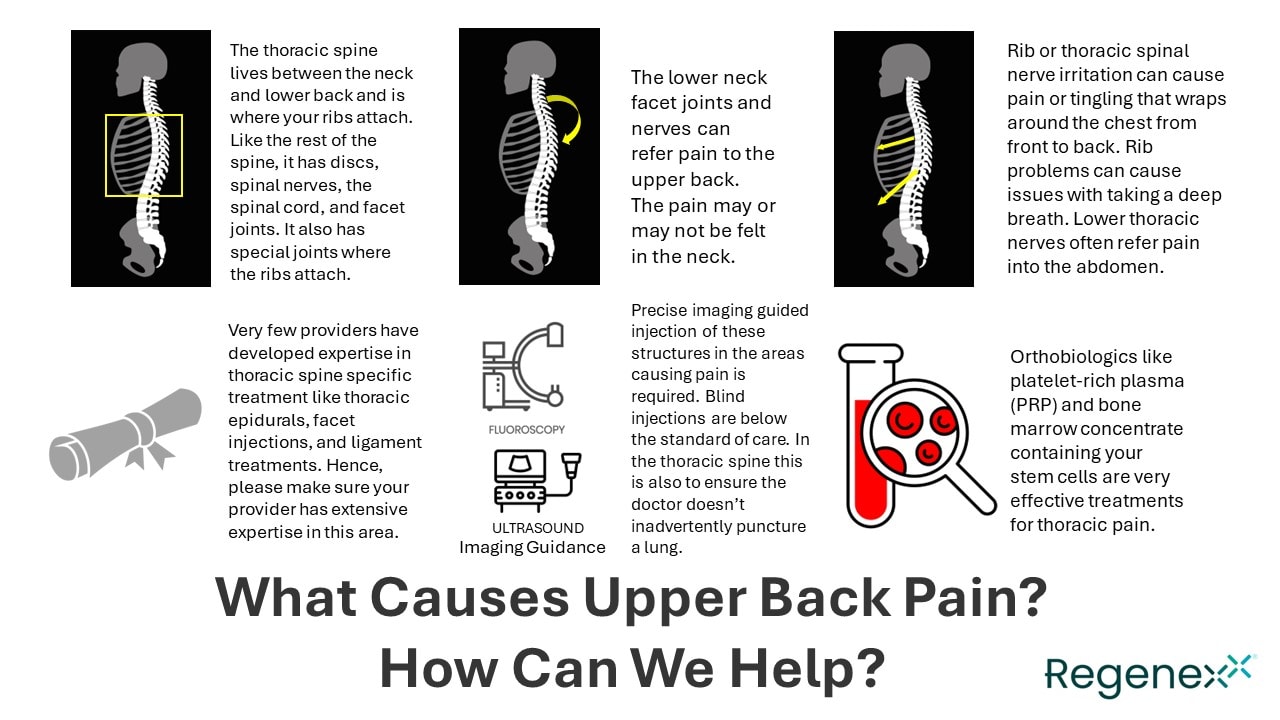Can You Treat Thoracic Pain with Orthobiologics?

The thoracic spine lives between your neck (cervical spine) and lower back (lumbar spine). It’s where all of your ribs attach and it causes upper and mid back pain in lots of patients but is rarely treated. Why? Let’s dig into that today.
Let me tell you a story from my practice that illustrates the challenge of thoracic pain. A patient walked in about 7-8 years ago with severe pain in his abdomen. He had the million-dollar work-up at the local university which showed no specific stomach pathology. He was eventually referred to a pain management physician at the university who thought that this pain could be from his thoracic spine. So what did this genius do? He injected the upper part of his lower back! Why? Because that university-based interventional spine physician didn’t have the skill level to inject the thoracic spine. When that didn’t work, this patient had created a suicide plan and at the same time, his friend referred him to me. It was clear in about 2 minutes of exam that his abdominal pain was coming from an irritated nerve in his lower thoracic spine which fit with his MRI images. These lower thoracic spinal nerves wrap around the upper abdomen. We injected platelet growth factors around that nerve through a fluoroscopically guided transforaminal epidural and his pain was gone within a few weeks.
For many physicians, the problems end at the neck and start up again in the lower back, skipping over the thoracic spine. Why? The first is a lack of training on how to evaluate the thoracic spine. Outside of pushing around to see if this or that hurts, 95% of doctors who treat the spine have never been taught about thoracic spinal nerve territories (dermatomes) or how the ribs work, or what structures in this area most commonly cause pain. In addition, because of the lungs, injections in this area carry more risk and take a greater level of technical expertise. Hence, many experienced interventional spine trained physicians have very little thoracic injection experience.
However, as you can see from the infographic above, there are legitimate reasons why in a chunk of spinal pain patients the thoracic spine needs to be thoroughly examined and treated. However, these poor patients often don’t get the treatment they need. So who has special thoracic skills? You just have to ask the following question, “In the past 12 months how many thoracic transforaminal epidurals has Dr. X done?” If the answer is less than 10, hang up the phone and call another clinic until you find one that has done dozens or more. Why? Because that’s how much thoracic nerve pain is out there.
In addition, orthobiologic injections like PRP, platelet lysate, and bone marrow concentrate work well in the thoracic spine just like they work well in the neck and lower back.
The upshot? If you or a loved one is experiencing pain in the ribs, unexplained abdominal pain, pain when taking a deep breath, wrap-around pain from the upper back forward, or unexplained upper back pain, find an interventional spine trained doctor with experience in the thoracic spine and orthobiologics who can help! Please don’t let them end up neglected and suicidal like my former patient!

NOTE: This blog post provides general information to help the reader better understand regenerative medicine, musculoskeletal health, and related subjects. All content provided in this blog, website, or any linked materials, including text, graphics, images, patient profiles, outcomes, and information, are not intended and should not be considered or used as a substitute for medical advice, diagnosis, or treatment. Please always consult with a professional and certified healthcare provider to discuss if a treatment is right for you.
